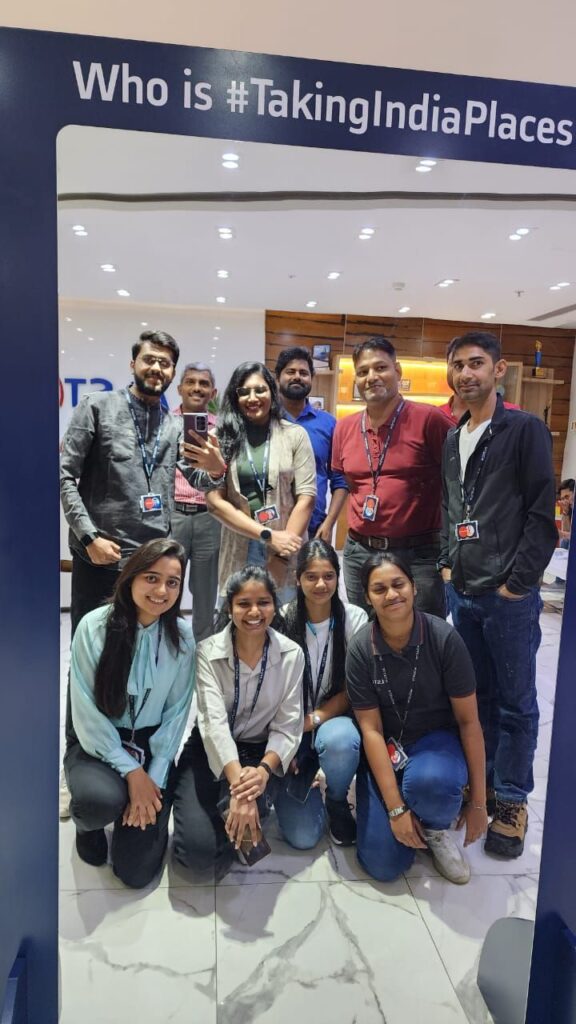Presenting the 60th edition of Intraskope’s Spotlight on Internal Communication Series featuring Megha Chaturvedi – Communication Lead, Alstom India.
Megha Chaturvedi is a results-oriented communications professional with over 15 years of experience across diverse industries. Megha has a proven track record of collaborating with organizations to develop communication strategies that effectively drive business objectives. She seamlessly transitions between consultancy and corporate roles, showcasing her versatility and adaptability.
Megha’s expertise encompasses a wide range of communications disciplines, including corporate reputation management, crisis handling, integrated campaign planning, and policy communications. Her skills and experience make her a valuable asset in any setting.
An ambivert by nature, Megha is passionate about continuous learning. She is always eager to explore new trends, engage with people, and discover new ideas, stories, hobbies, and places. In her spare time, she dedicates herself to pro-bono consulting, mentoring students, and listening to podcasts, further enriching her professional and personal life.
In this interview, Megha addresses core issues of trust and transparency plaguing internal communications and the need to be straightforward and share more openly with staff. I personally liked a campaign she led which involves employees to engage on the company’s purpose and mission making it an inclusive approach to communication.
Watch the complete video interview on YouTube or read the transcript below.
Megha Chaturvedi – Communications Lead, Alstom India
1. What does internal communication mean to you?
To simply put, Internal Communications is the HEARTBEAT of any organization. In fact, I will go beyond that, and quote Mr. Bill Gates when he rightly captured the essence of the function by saying: “Like a human being, a company has to have an internal communication mechanism, a “nervous system,” to coordinate its actions.” I believe and have witnessed that the quality of internal communication can shape the health and productivity of the organization. A strong and consistent communication system can help reinforce the company’s values and bring employees together. It contributes to the overall personality and identity of the organization by shaping employee behavior. Therefore, it should not be an afterthought.
2. Please share an example/campaign that you are personally proud of working on and that made a significant impact to an organization in the recent past
I had the fortune of supporting our debut campaign in India for Alstom— #TakingIndiaPlaces. Trains have been part of the country’s economic and cultural fabric. From nostalgic journeys to hometowns in the summer vacations, to modern day commutes in metro trains, almost everyone has experienced the magic of railways. The freight trains that crisscross India play a vital role in keeping the economy moving. By building on the core tenets of the railways’ function – taking people and goods from one place to another; this campaign plays upon the words ‘Taking India Places’. It focuses on the role trains have played in the country’s growth both at home, and on a global stage. At the heart of the campaign was a hero film that touched upon every Indian’s love affair with trains and their role in our daily lives. This story was intertwined with Alstom’s role in India’s mobility transformation, highlighting its commitment to innovation and sustainability. We installed large Mirrors at all our sites including factories with branding— Who is #TakingIndiaPlaces? Employees shared Mirror selfies across locations sharing “I am #TakingIndiaPlaces because….” In addition to the mirror campaign, Alstom Employees across the country acted as ambassadors, spreading the message about their film on their own social media profiles, providing a multiplier effect for the reach. In addition, watch parties were organized across Alstom India locations along with promotional activities for the film.

Through this campaign, we were able to:
• Highlight Alstom’s contribution in India by India for India and the world and generate positive brand awareness.
• Instill a sense of pride in employees and partners.
• Make rail transport more desirable highlighting their efficiencies and technologies brought in over the decade.
What it resulted in:
• 90% of respondents to a post-campaign survey reporting that they had a more positive view of the brand and campaign’s success.
• #TakingIndiaPlaces campaign had a combined Engagement Rate of over 7% with the mirror selfie tweet of Alstom employees receiving the highest Engagement Rate of 18% on Twitter
• 70% average open rate for all internal communications
• Nearly 60% onsite engagement with our employees through Watch Parties

3. What is the biggest challenge you face while going about managing internal communication?
Internal Communicators work at the intersection of many functions— employee engagement and development, DEI and business. It, therefore, a cross-functional domain. That requires project management in terms of optimizing interests, schedule, agendas in a manner that keeping the organization’s interest intact, a rich and timely comms plan/initiative is on the go. And more often than not, a lot of variables (inputs, suggestions) are not in our control and I wish there was a way to make it smoother for all involved.
4. What according to you is the biggest opportunity that internal communicators have?
One of the rules of any game is that every challenge contains an opportunity in disguise. Amidst the current business context of mass layoffs, business restructuring/change management, advent of AI and emerging technologies, DEI; and geo-political landscape of deep polarization, online activism, climate change, so and so forth, the function has a greater opportunity to claim a respectable portion in the organizations’ strategy pie by being more agile, measuring and showing impacts and applying “MVP” thinking and refine constantly. And there is no better time, than right now.
5. How can internal communicators add more value to the business?
By telling Truth to power! Employees can handle the truth. And there’s no reason to be anything but straightforward in what we communicate. Employees want to know what we know, when we know it. Our aim isn’t to make them happy with what we say. Our goal is for them to understand it and how what we’re communicating will help advance the business. Therefore, by building a culture of transparency and timeliness, two traits that employees value, internal communications can foster a strong sense of #OneTeam— especially in the time of crisis, change or big business milestone.
6. What skills must they have or develop?
– Writing isn’t just a skill, it’s THE skill: Master the pen, and you’ll master internal communications.
If you can distil long and complex information into clear and concise messaging that engages readers, you will succeed in this field.
– A lot of success in the function today hinges on digital proficiency. Proficiency with communication, creative and analytics tools and platforms is helpful. In a tech-driven, remote/hybrid work environment, digital savviness ensures your communications are efficient, dynamic, and measurable.
– Intuitive yet needs to be stated. project management skills are critical. Many internal communication initiatives involve coordinating across teams and departments, requiring strong project management skills to ensure timelines and deliverables are met.
– Last but not the least, skills such as listening, emotional quotient, and interpersonal adeptness cannot be stressed enough as IC is a collective effort.
7. What is your advice for people who are keen to join internal communication and make a career?
Beyond the skills I just shared with you, to someone who is keen to make mark in internal communication, I would say:
– Be ready to learn and unlearn – with the world fast changing, as an internal communicator, be ready to adapt and upskill yourselves. That will make your comm strategy far richer and relevant— in turn making employees better informed. You’ll earn higher engagement. A win-win.
– Never think your role as second to any other function within the larger umbrella of communications. Internal communication can often be referred to as the “fluffy stuff”, and that’s so wrong. As Internal communicator, you’ll have the finger on the pulse of employee behavior and voices far closer than anyone else. Plus, there are studies that prove the financial costs of poor internal comms and hence cherish your roles and responsibilities!
– Always start with the ‘Why’. Hallmark of a great internal communications is when it can answer that question and hence creating clear business value.
– Also, internal communications as a function is a top down responsibility. Right from you to top up at the CEO. *Michael Scott used the annual Dundie Awards ceremony as a morale booster in The Office.
8. What is your advice for women who want to make a mark in this domain and what must they do differently?
Businesses cannot run or be successful in silos and silence and it is the words and actions that inspire and motivate stakeholders — employees and others. I don’t believe any gender has a particular advantage or disadvantage in the communications profession. Whether male or female, effectively bringing the business to life for stakeholders requires understanding their priorities and environment, and then delivering clear messages that resonate. Accuracy and creativity in this approach can determine the success or failure in any aspect of communications— including internal comms. I would only add that women generally have high EQ and can read the organizational mood music well. Keep honing and leaning-in on that skill to your advantage.
9. With COVID-19 and other crises, how must internal communications engage? What has changed or will change? Examples of how your organization has helped reassure employees and navigate the crisis as it unfolds.
I recollect that when I started my career in an agency, I hardly had an engagement with the internal comms lead from my clients end and the function often was considered as the poor cousin of external comms, leading to smaller teams, reduced budgets, no agency support and, in many cases, receiving less respect and attention from senior management. Come COVID, IC took CenterStage as the pandemic heralded the era of remote/hybrid working. Employee engagement and wellbeing was primary. Peter Drucker’s words— “Culture eats strategy for breakfast” were fast becoming understood and acknowledged. I remember in my previous in-house role at a MNC mining company, right at the peak of COVID, I realized that one doesn’t need to do a lot to have a big impact. If budgets are tight, you don’t need to do big flashy events and expensive campaigns. Just make sure employees are hearing company updates in a timely fashion, that leadership is visible—whether that’s in Town Halls or focused group engagements –and speak to your people and hear how they are doing, first hand.
10. Can you share one trend that you spot with internal communications?
With diminishing attention spans and information fatigue, we are currently experiencing an engagement crisis. Average engagement has dropped to 36%, with 13% of our workforce classified as disengaged, contributing to a growing atmosphere of negativity (Source: Gallup). In today’s world, people are increasingly skimming content. We are bombarded with overwhelming amounts of information, making it difficult to create messages that are memorable and meaningful. Following the recent award entries, the IC campaigns that truly stood out were the ones which employed creativity, multi-channel approach, keeping employee experience at the center. For example: DHL’s campaign— Fired Up, Ready 2 Go! Designed to unite, engage, and inspire its 7,600-strong workforce across 22 countries by leveraging music and the company’s digital platform, Smart Connect, this internal communications campaign involved creating an original song and music video featuring the AP Management Board and employees, supplemented by employee contests and activations to boost engagement. The campaign successfully increased doubled site visits on Smart Connect, strengthened their sense of belonging, promoted regional interaction, and showcased leadership in a new light. The positive feedback from a post-campaign survey, increased Smart Connect usage, and unsolicited social media posts by employees attested to the campaign’s success in meeting its objectives.
11. If there is one aspect of internal communications you would like to change, what would that be?
I would say, the notion that IC is merely about sending emails or making videos and sharing with employees to facilitate one-sided information flow. And hence perhaps, the rationale behind inadequate budget, resourcing, external creative support. As communicators we owe it to ourselves to make the business leaders understand and recognize the power of power of creative internal storytelling— one that meets employees where they are.
Liked the interview? Post your comments and share it with your network.
Keen to contribute and participate in the ongoing series on Intraskope where we put the spotlight on thought leadership, great ideas, and practical solutions?
If you are an internal communication leader working in a firm or a not-for-profit anywhere in the world and have an internal communication case study, campaign, research insight or a guest blog post to share please contact me on aniisu3@gmail.com
Look up the previous stories from organizations featured on the Intraskope’s Spotlight on Internal Communication Series here – Northern Trust, AXA Business Services, Subex, global insurer, Standard Chartered Bank, BASF, Applied Materials India, Microsoft UK, Times Group, Samsung, Falabella, Cisco, Brillio, UAE Exchange, Apeland, M.H. Alshaya Co, Proctor & Gamble, Infosys, SOBHA Ltd., ICICI Securities, First Advantage, CK Birla Group, TVS Motors, GE, Suzlon, Tata Sons, Percept, Knight Frank, TCS Europe, Vedanta, Oxfam, Danske Bank, Diageo, Pandora, Symantec, ISS Global Services, Telia, Thomson Reuters, IBM, General Motors, Intelligence India Software Solutions, Philips, Refinitiv, Mastercard, VFS Global, Ittiam Systems, Bridgestone India, Indian automotive company, Uber, L&T Metro Rail Hyderabad Limited, Microsoft India, Hitachi Rail, OYO, Alfa Laval, BD, SITA, EY & COOP.
Intraskope (www.aniisu.com) is one of the first blogs on internal communications globally. Begun in 2006, the blog has today over a 1000 posts on topics such as employee engagement, leadership communication and employee branding and receives thousands of visits from across the world. The blog, receives visitors from over 50 countries globally and offers learning resources for practitioners, academicians, and students including industry workshops, research reports, and checklists.
Intraskope has been featured on leading global internal communication forums like Simply-Communicate, IC Kollectif and International Association of Business Communicators. It is hosted by Aniisu K Verghese, author of Inclusive Internal Communications (2023), Internal Communications – Insights, Practices & Models (2012) and Get Intentional (2021).
Here are Internal Communications resources you can use:
- Learn: Internal Communications Fundamentals Course on Thinkific
- Internal Communications Series: https://forms.gle/KcqmPzLwq7NQi5Km6
- Chat with Aniisu – Internal Communications: https://meet.brevo.com/aniisu-k-verghese/ask-aniisu-
You can also visit my website www.intraskope.com and You Tube channel to know more about my work.
#internalcomms #change #behaviors #purpose #DEI #trust #internalcommskills #skilling #engagement #internalcomms #digitalcommunication #upskilling #internalcommunications #writing #covid19 #covid19comms #brand #people #empathy #leadership #learning #planning #communication #strategy #policycommunication #crisis



